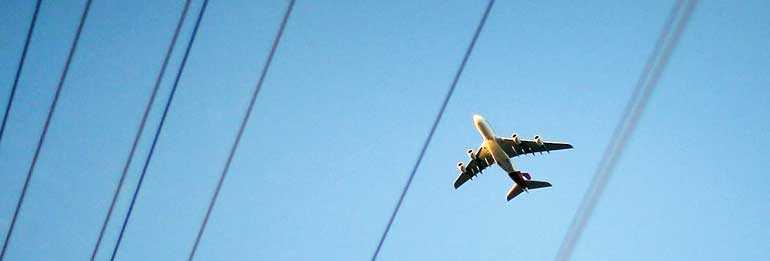Monday Mar 10, 2025
Monday Mar 10, 2025
Thursday, 9 January 2020 00:00 - - {{hitsCtrl.values.hits}}

WASHINGTON/MONTREAL (Reuters): Several major airlines said on Wednesday they were re-routing flights to avoid airspace over Iraq and Iran after the Federal Aviation Administration banned US carriers from the area following an Iranian missile attack on US-led forces in Iraq.
Iran fired more than a dozen ballistic missiles from its territory on at least two Iraqi military bases hosting US-led coalition personnel early on Wednesday, the US military said.
The FAA said it issued the airspace ban, which also includes the Gulf of Oman and the waters between Iran and Saudi Arabia, “due to heightened military activities and increased political tensions in the Middle East, which present an inadvertent risk to US civil aviation operations.”
Several non-US airlines had flights over parts of Iraq and Iran at the time, according to FlightRadar24 data. They are not directly affected by the FAA ban, but foreign carriers and their national regulators typically consider US advice carefully when deciding where to fly.
Before the latest guidance, the FAA had already prohibited US carriers from flying below 26,000 feet over Iraq and from flying over an area of Iranian airspace above the Gulf and Gulf of Oman since Iran shot down a high-altitude US drone last June.
Carriers are increasingly taking steps to limit threats to their planes after Malaysia Airlines Flight MH17 was shot down in 2014 by a missile over Ukraine, killing all 298 people on board. Re-routing around conflict airspace adds to flight times and burns extra fuel.
Transport Canada said it was in close contact with the FAA about the situation in the Middle East and that Air Canada was altering its routes.
Singapore Airlines Ltd. said after the attacks that all of its flights would be diverted from Iranian airspace. Malaysia Airlines said it did not fly over Iraqi airspace and would re-route to avoid Iran as a result of the attack. Taiwan’s China Airlines said it would not fly over Iran or Iraq because of the tension.
Australia’s Qantas Airways Ltd. said it was adjusting flight paths to avoid airspace over Iraq and Iran until further notice, adding up to 50 minutes to Perth-London flights and requiring it to reduce passenger numbers to carry the necessary fuel.
Dubai-based Emirates Airline and flydubai each cancelled a return flight to Baghdad on Wednesday after Iran’s missile attack and said it would make further operational changes if required.
Qatar Airways said its flights to Iraq were operating normally.
Korean Air Lines Co. Ltd. and Thai Airways said they had been avoiding Iranian and Iraqi airspace before the attack on US troops.
OPSGROUP, which advises airlines on security, said the new US airspace bans were “significant”, particularly given that the entire overwater airspace in the region is now unavailable.
“Flights headed to/from the main airports in the region such as Dubai will now need to route through Saudi Arabia’s airspace,” it said on its website.
An international aviation team has been activated to support “effective co-ordination and communication” between airlines and countries as tensions mount in the Middle East after a US drone strike killed an Iranian military commander, global airlines body IATA said on Tuesday.
Airlines and the UN aviation agency have started to monitor strategic airspace over Iran and Iraq. With some commercial carriers still serving those countries and others flying over their airspace, the International Air Transport Association also issued a statement reminding countries of their obligation to communicate potential risks to civil aviation.
“It is critical that states live up to this obligation as tensions in the Middle East rise,” the group said, days after the killing of Iran’s General Qassem Soleimani on Friday plunged the region into a new crisis.
The co-ordination team operated by IATA and the International Civil Aviation Organisation (ICAO) was activated as a “standard precautionary measure,” in the event that contingency measures are required by airlines, IATA said in a statement to Reuters.
The team brings together airlines, regulators and air navigation service providers to ensure any potential risks to aviation are shared quickly, an industry source familiar with the group said.
Discover Kapruka, the leading online shopping platform in Sri Lanka, where you can conveniently send Gifts and Flowers to your loved ones for any event including Valentine ’s Day. Explore a wide range of popular Shopping Categories on Kapruka, including Toys, Groceries, Electronics, Birthday Cakes, Fruits, Chocolates, Flower Bouquets, Clothing, Watches, Lingerie, Gift Sets and Jewellery. Also if you’re interested in selling with Kapruka, Partner Central by Kapruka is the best solution to start with. Moreover, through Kapruka Global Shop, you can also enjoy the convenience of purchasing products from renowned platforms like Amazon and eBay and have them delivered to Sri Lanka.
Discover Kapruka, the leading online shopping platform in Sri Lanka, where you can conveniently send Gifts and Flowers to your loved ones for any event including Valentine ’s Day. Explore a wide range of popular Shopping Categories on Kapruka, including Toys, Groceries, Electronics, Birthday Cakes, Fruits, Chocolates, Flower Bouquets, Clothing, Watches, Lingerie, Gift Sets and Jewellery. Also if you’re interested in selling with Kapruka, Partner Central by Kapruka is the best solution to start with. Moreover, through Kapruka Global Shop, you can also enjoy the convenience of purchasing products from renowned platforms like Amazon and eBay and have them delivered to Sri Lanka.